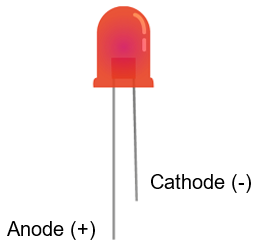Using LEDs
A light-emitting diode (LED) only lets electricity flow in one direction making light as it does so. It is important to make sure that the LED is connected the right way round - ie its polarity matters. Other components such as resistors can be connected either way around, so for them polarity is not important.

There are two ways to recognise the correct orientation of an LED. The anode (positive connector) is usually longer than the cathode (negative connector) as shown below. There is also a flat section on the casing closest to the cathode.

NB. When using an LED in a circuit, it needs to be protected by a resistor. If too much current flows through an unprotected LED it can explode. Use a resistor value between 350Ω and 1000Ω in series.
